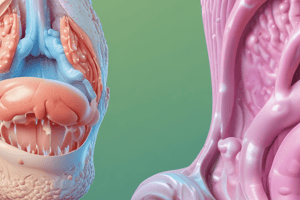Podcast
Questions and Answers
What is the impact of adult male non-neurogenic urinary incontinence on a patient's quality of life and healthcare resources?
What is the impact of adult male non-neurogenic urinary incontinence on a patient's quality of life and healthcare resources?
- It has no significant impact
- It has a moderate impact
- It has a significant impact (correct)
- It has a minimal impact
What is required for the management of men with urinary incontinence?
What is required for the management of men with urinary incontinence?
- Comprehensive history-taking and focused physical examination
- Only basic investigations
- Basic investigations and focused physical examination
- Comprehensive history-taking, focused physical examination, and basic investigations (correct)
What is necessary for meeting the increasing prevalence and patients' expectations in the management of male urinary incontinence?
What is necessary for meeting the increasing prevalence and patients' expectations in the management of male urinary incontinence?
- Development of novel drug therapies and minimally invasive surgery (correct)
- Increased reliance on basic investigations
- Focus on traditional treatment options
- Minimizing the discussion about treatment options
What is involved in the management of men with urinary incontinence?
What is involved in the management of men with urinary incontinence?
Which aspect has seen considerable advances over the past decade in terms of male urinary incontinence?
Which aspect has seen considerable advances over the past decade in terms of male urinary incontinence?
Flashcards are hidden until you start studying
Study Notes
Impact of Adult Male Non-Neurogenic Urinary Incontinence
- Adult male non-neurogenic urinary incontinence has a significant impact on a patient's quality of life, affecting their physical, emotional, and social well-being.
- It also leads to a substantial economic burden on healthcare resources.
Management of Men with Urinary Incontinence
- Effective management of men with urinary incontinence requires a comprehensive approach, involving a multidisciplinary team of healthcare professionals.
- A thorough diagnosis, including a detailed medical history, physical examination, and relevant investigations, is necessary to identify the underlying cause of incontinence.
- A range of treatment options, including lifestyle modifications, behavioral therapies, and surgical interventions, should be considered to address the patient's specific needs.
Meeting Increasing Prevalence and Patients' Expectations
- To meet the increasing prevalence and patients' expectations in the management of male urinary incontinence, healthcare providers must stay updated with the latest advances in diagnostic and treatment options.
- Patient-centered care, emphasizing individualized treatment plans and education, is essential to improve patient outcomes and satisfaction.
Aspects of Management
- The management of men with urinary incontinence involves a range of aspects, including pharmacological interventions, minimally invasive procedures, and surgical interventions.
- A comprehensive understanding of the underlying causes of incontinence, including anatomical, physiological, and psychological factors, is necessary to develop effective management strategies.
Advances in Male Urinary Incontinence
- The past decade has seen considerable advances in the field of male sling procedures, offering a minimally invasive and effective treatment option for men with urinary incontinence.
Studying That Suits You
Use AI to generate personalized quizzes and flashcards to suit your learning preferences.




